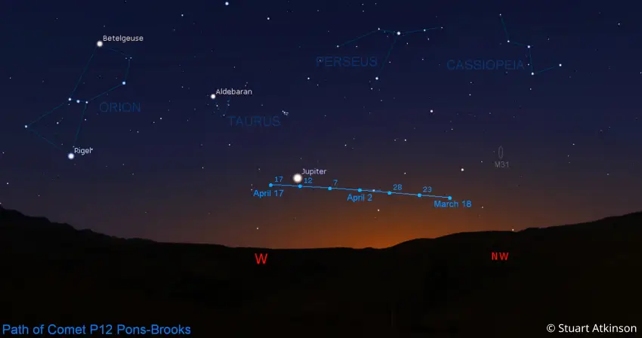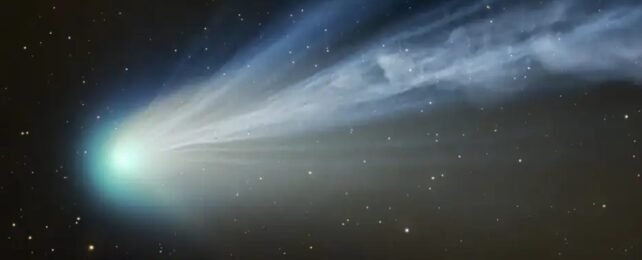Eclipse watchers might be in for a two-for-one special on Monday.
On April 8, the moon will blot out the sun over a significant portion of the US, plunging cities from Texas to Maine into several minutes of darkness.
But there will be another exciting astronomical event to keep an eye out for.
For the first time in 71 years, Comet 12P/Pons-Brooks, a.k.a the "Mother of Dragons" or "Devil comet," is coming relatively close to the sun. Don't worry, it's not going to collide with Earth.
This unusually large comet is estimated to be as big as Mount Everest, and it gets its nickname "Devil comet" from the horn-shaped outbursts located in its coma — the localized cloud of gas, dust, and ice particles that wraps the comet's solid nucleus in a nebulous envelope.
During the total solar eclipse, when the moon completely eclipses the sun, the skies will darken enough that you may barely be able to see the Devil comet with your naked eye. Or you can whip out a pair of binoculars or a telescope.
Just remember, it's never safe to look directly at the sun during a solar eclipse without eclipse glasses or through a solar lens filter. The one exception to this rule is during the brief window of totality, which will last a few minutes, and when the skies will darken enough for a chance to spot the Devil comet if the skies are clear enough.
When and where to see the Devil comet
To find Pons-Brooks, first look toward the eclipsed sun for the planet Jupiter, it will appear as a small bright point of light to the upper left.
After you've spotted Jupiter, look slightly up and to the right. The comet will be between Jupiter and the sun, but closer to Jupiter.
In close-up photos, the comet appears as a green streak in the sky due to the high levels of dicarbon it contains that emit green light.

But, if you spot it during totality on Monday, the comet will likely show up as a tiny gray smudge, said Robert Massey, deputy executive director at the Royal Astronomical Society on its website.
It will be hard to spot so just make sure to enjoy the brief moments of totality, as well. Time will pass quickly, and there are plenty of other spectacular phenomena to watch for during the event, besides the Devil comet.
How bright will the Devil comet be?
During the eclipse, the Devil comet will still be two weeks away from reaching its closest distance to the sun, which is when it would be at its brightest.
On April 8, it will have an estimated apparent magnitude of about 4.9, which means it will be just at the edge of what the human eye can see, said Geronimo Villanueva, associate director for strategic science of NASA's Solar System Exploration Division.
But comet visibility is difficult to forecast. Comets' brightness depends on how sunlight interacts with their coma. Because a comet's distance from the sun, and its coma, is constantly changing during orbit, so does its brightness.
Plenty of comets predicted to be dazzling have fizzled out by the time they reached Earth, while others have put on a surprisingly good show. As for the Devil comet, we'll just have to wait and see.
One benefit of Pons Brooks is that it's cryovolcanic, meaning it tends to erupt fairly frequently. When that happens, the resulting cloud of ice and dust around it expands, making it appear brighter. So an eruption during the total solar eclipse would be a spectacular treat if it happened.
However, if you don't see the comet on April 8, try again in the days leading up to April 21, when it will be nearest to the sun and brightest.
As the days pass, its path across our skies will move closer to Jupiter, eventually passing it and ending up on the planet's left side by April 17.
This article was originally published by Business Insider.
More from Business Insider: